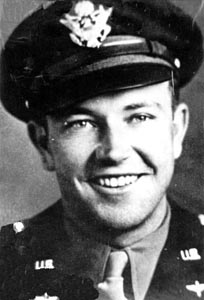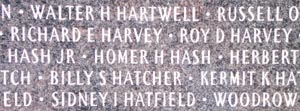

Remember...
Homer Harold Hash
1919-1944
It is probable that future war will be conducted by a special class, the Air Force, as it was by the armored knights of the Middle Ages.
Sir Winston Churchill
 |
Remember... Homer Harold Hash
|
Homer entered the service in 1942, and was selected as an aviation cadet for pilot training in the Army Air Corps. During WW II, the Army Air Corps was a part of the U. S. Army but gradually those in the aviation field became identified as the Army Air Force. He received training in California and eventually received his commission and pilot's wings at Luke Field, Arizona. He took additional flight training at MacDill Field, Florida, with accompanying combat training in Louisiana.
Homer's primary training was in the Martin Marauder B-26, a twin-engine medium bomber designed for a five-man crew. In the early production models, several problems plagued this aircraft, and these problems caused much apprehension to prospective crews and many sought to avoid assignment to this aircraft. The bomber, because of the high wing design, had the unwanted necessity of dangerous 130 mile-per-hour landings. Refinements to the design in later production models eliminated most of the problems, but the necessity of a high-speed landing remained with all production models throughout the war.
When Second Lieutenant Homer H. Hash and his crew received orders to overseas duty, they started the trip to Europe on October 27, 1944, by flying their Marauder south to Brazil and then eastward across the Atlantic to the continent of Africa. Turning northward, the flight, although tiring, was uneventful until approaching the airfield in Dakar, Senegal, French West Africa, on November 9. For some reason, mechanical problems or perhaps the high-speed landing, the aircraft crashed upon landing, inflicting injuries that resulted in Homer's death.
The military buried 2nd Lt. Hash's body and the bodies of other crewmen during the duration of the war in a local cemetery in Dakar. After the cessation of hostilities in Europe, Homer's parents requested that his body be returned to the United States. The American Graves Administration, charged with the responsibility of recovering the bodies of all branches of service during WW II, transported his body, like thousands of others, to New York on one of the many funeral ships assigned the task of returning the American dead. His body was returned to Huntington and on June 20, 1948 and was buried in the Hash family plot in Huntington's Ridgelawn Cemetery, Section A, Plot 188, Grave 8.
Biography and Pictures provided with the assistance of Larry L. Legge

West Virginia Archives and History welcomes any additional information that can be provided about these veterans, including photographs, family names, letters and other relevant personal history.